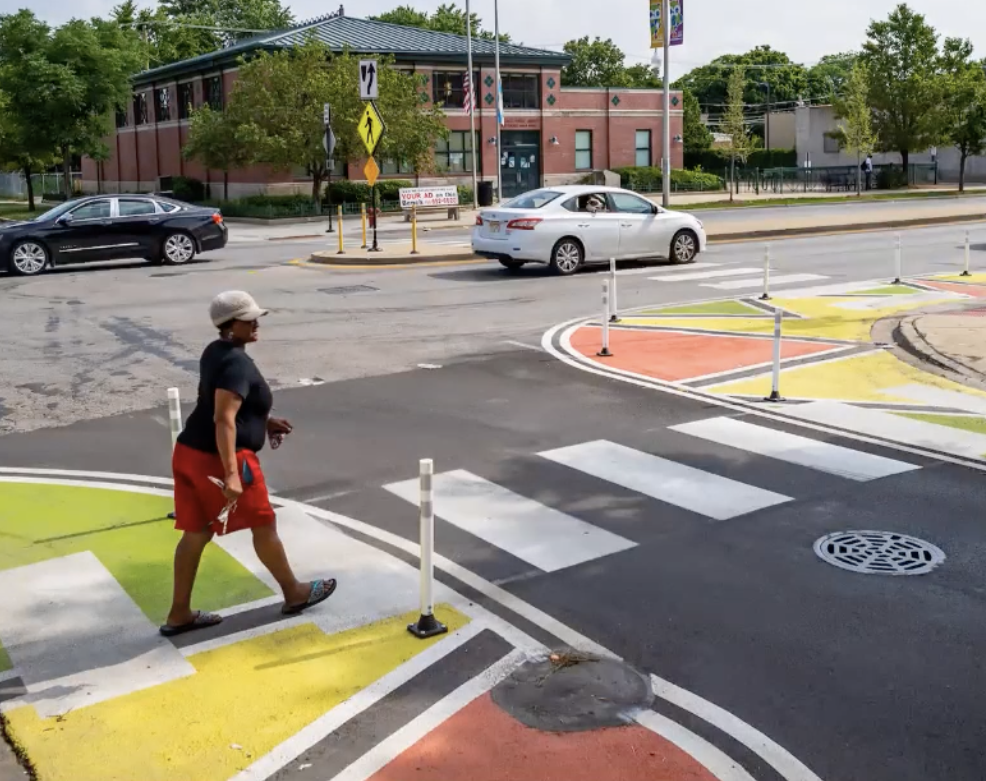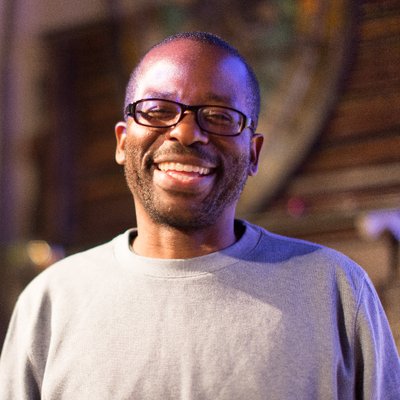Update 11/8/21, 10:15 PM: CDOT provided the following explanation for the discrepancy in Chicago crash fatality numbers discussed below.
These are numbers from August, they may have been revised further as the cases were reviewed (because the total was revised upwards, the percentage increase comes out to be a smaller number):
There were 151 traffic fatalities in 2020 (based on current IDOT data) compared to 118 in 2019 based on IDOT data - and 33 more fatalities divided into 118 is 28 percent increase.
In January, these were the CPD numbers we were relying on, which you may have reported:
Through the end of 2020, total traffic fatalities are up by 45 percent, with 139 fatalities, 43 more deaths than 2019, according to provisional Chicago Police Department data.
Today the Chicago City Council's Pedestrian and Traffic Safety Committee discussed the city's Vision Zero program to eliminate serious and fatal traffic crashes, a conversation apparently initiated by 1st Ward alderman Daniel LaSpata. "By improving design and investment, we can reduce crashes and fatalities," he tweeted the day before. "I remain committed to this goal."
The hearing started with a public comment period, during which the only speaker was Oboi Reed, the leader of the mobility justice nonprofit Equiticity. He called on the Council to pass an equitable traffic safety ordinance that formally removes police enforcement from Chicago’s Vision Zero plan and other traffic safety frameworks. Reed argued that the root cause of traffic violence impacting African Americans and Latinos, demographics that are disproportionately affected by crashes, is structural racism.
He also asserted that the Chicago Police Department can't be trusted to fairly enforce traffic laws, calling it "a rogue, out of control institution, which is racist, abusive, and corrupt." He noted that the force still isn't in compliance with the Obama administration-era U.S. Department of Justice consent decree that requires reform of the department.
Reed added that research shows that redesigning streets to protect vulnerable road users and encourage safe driving, plus culturally-relevant safety outreach and education, are more effective strategies to prevent crashes than traffic policing.
Next LaSpata explained his own proposed ordinance to change all references to traffic "accidents" in the Chicago Municipal Code, which he called, "a fairly simply ordinance, but with a much broader impact and consequence to it." He noted that the way we talk about things indicates "the values and the actions that we are committed to."
"If I talk to you about 'an accident,' that can be something as simple as me knocking my coffee cup onto my keyboard," LaSpata added. "There is no intention behind an accident. There is intention behind the actions that lead to traffic crashes and injuries and fatalities in our city." He gave examples of intentional choices that contribute to traffic violence, such as driving distracted and speeding. "Even more broadly than that, the way we engineer and configure our infrastructure, our roads and our public way, reflect intentional choices."

On the bright side, LaSpata noted that we can also prevent injuries and deaths through intentional choices. "We have the power as aldermen to use our influence over policy and infrastructure to eliminate serious [traffic] injuries and fatalities from the streets of Chicago."
LaSpata said he invited the Chicago Department of Transportation to provide an update on Vision Zero. Vig Krishnamurthy, deputy commissioner for the Division of Project Development, gave the presentation.
"Chicago thrives through the freedom of movement," said Krishnamurthy. "And yet sadly too many Chicagoans... are killed or severely injured or maimed in the pursuit of living this happy and prosperous life, through traffic crashes." He noted that the philosophy behind Vision Zero is that even one traffic death is unacceptable.
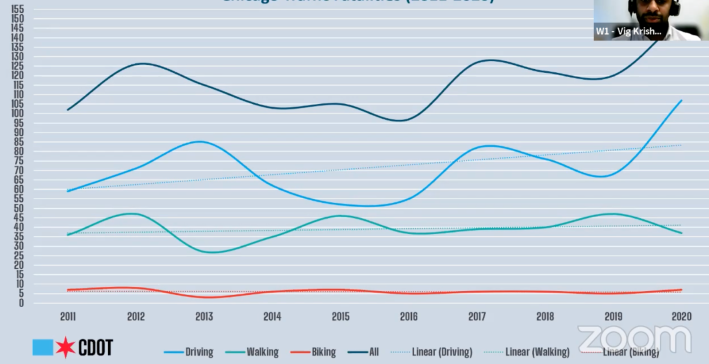
Krishnamurthy added that while there was a promising drop in on-street Chicago traffic deaths from roughly 2012 to 2016, "things have reversed in the wrong direction." In 2020 during the COVID-19 pandemic there were 151 total fatalities, a 26 percent jump compared to the previous year, which mirrored national and global trends, he said.
(These numbers don't jibe with a previous CDOT announcement that there were 139 total Chicago traffic fatalities last year, a 45 percent increase from 2019. A department spokesperson said the previously-announced number reflected provisional data and was later revised when more accurate stats became available, But that still doesn't explain how the percent of increase went down from 45 percent to 26 percent, despite the total number of 2021 fatalities rising from 139 to 151.)
Krishnamurthy added that this spike was initially attributed to less driving during lockdown, and less congestion meant that "the street became a little bit more like a racetrack."
However, Krishnamurthy noted that fatal crashes have still been on the rise this year, even as society has reopened and more cars are on the road, with an 18 percent increase in deaths between 2020 and 2021, both in Chicago and nationally. He added that the biggest percentage of increase in deaths has been among people traveling in cars, which jumped about 50 percent year-over-year.
He added that since 2019 there has been at least one traffic death in every Chicago ward. Krishnamurthy also noted that 32 percent of Chicago's fatal crashes take place in the summer, when people are more likely to be out and about. Year-round, a quarter of the deaths take place between 1 and 4 a.m., when roads are less congested and people are more likely to be driving while tired or intoxicated.
Krishnamurthy pointed out that factors in traffic deaths include street design, vehicle design (he mentioned high SUV grills and vehicle blind spots as contributing to fatalities), and social issues like drunk driving. He noted that on the cultural side there are "more airy-fairy types of questions" such as "What users and values do we design our transportation system for?" and why do catastrophes like airplane wrecks get more media coverage than daily carnage from traffic crashes. "That's really the root of today's ordinance, trying to change the notion that 'accidents' are normal."
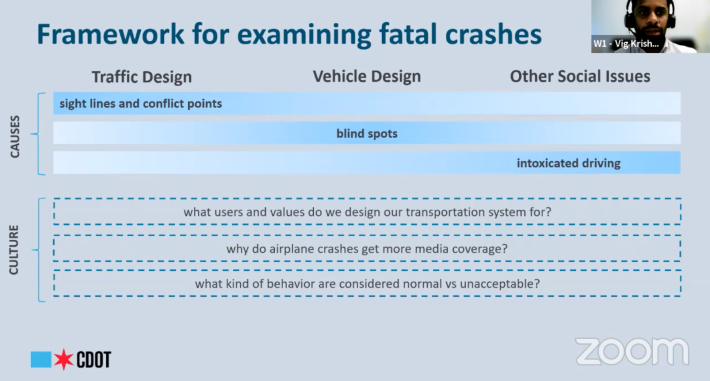
Krishnamurthy noted that CDOT has $20 million in Chicago Works infrastructure funds to use for Complete Streets projects to improve walking and biking safety and prevent motor vehicle crashes. Nearly 400 locations in the city have seen upgrades via this funding, he said. These initiatives can include streetscapes, modernizing traffic signals, paint-and-post sidewalk extensions, pedestrian islands, and more.
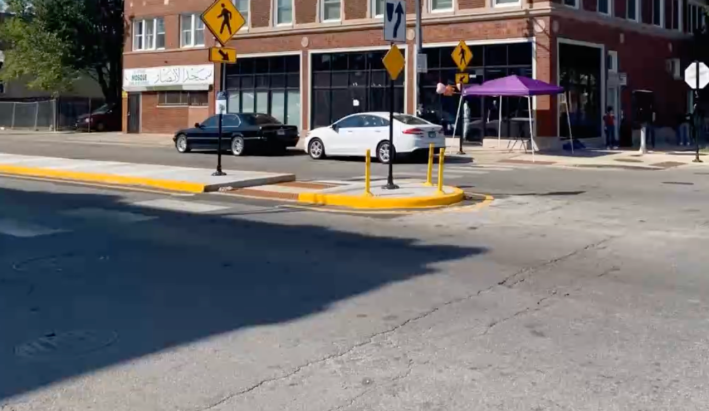
Krishnamurthy also highlighted Chicago's Open Boulevards program, which has pedestrianized streets on the Northwest, West, and South sides for community events this year, most recently on Drexel Boulevard in Bronzeville yesterday. "That's just part of the cultural change that our streets don't have to be carnage and mayhem, but can be something that we have a great feeling about."
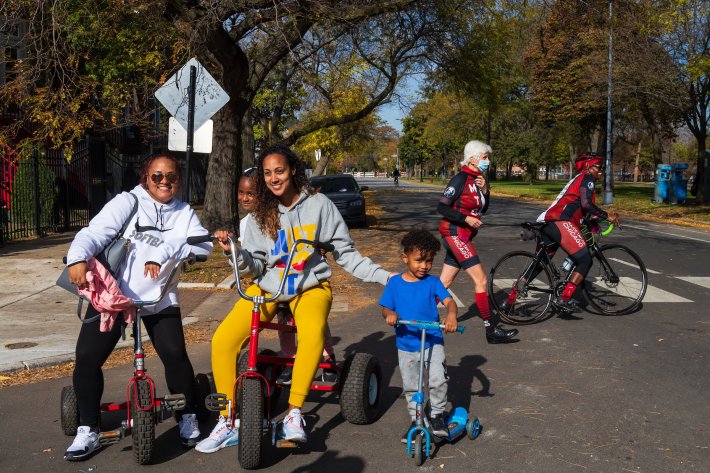
Doing the Q & A session, 31st Ward alderman Felix Cardona asked about snow removal from pedestrian islands and paint-and-post bump-outs. "When it snows, who's going to clear it?" That was a good question, because if these facilities are not properly maintained during the winter, they can actually make walking more difficult.
Krishnamurthy replied that last Friday CDOT staff meet with Streets and Sanitation officials to discuss snow removal. "It is an emerging issue," he conceded, noting that the transportation department is doing more pedestrian facilities, and more different kinds, than ever before. "We are trying to do better." He noted that CDOT has its own compact plows to use on protected bike lanes that are used for protected bike lanes (although not in a particularly timely manner.) He added that paint-and-post infrastructure is often eventually upgraded to concrete raised above street level, so snow clearance is less of an issue.
